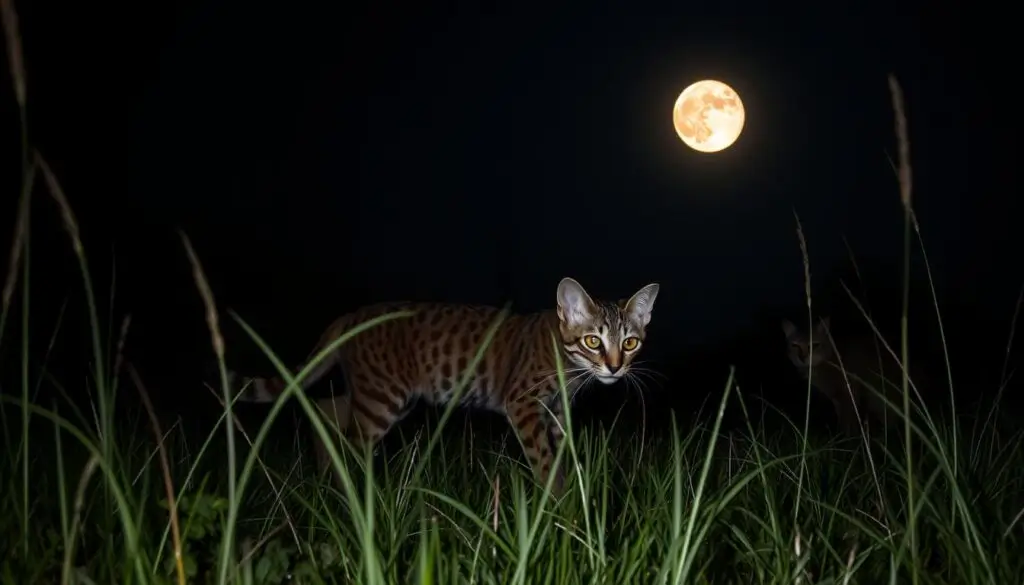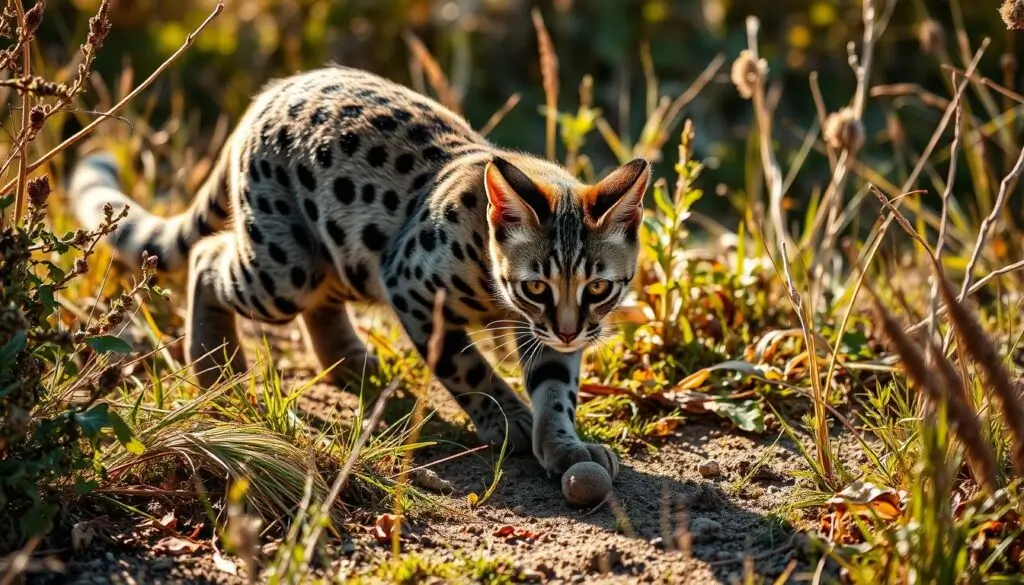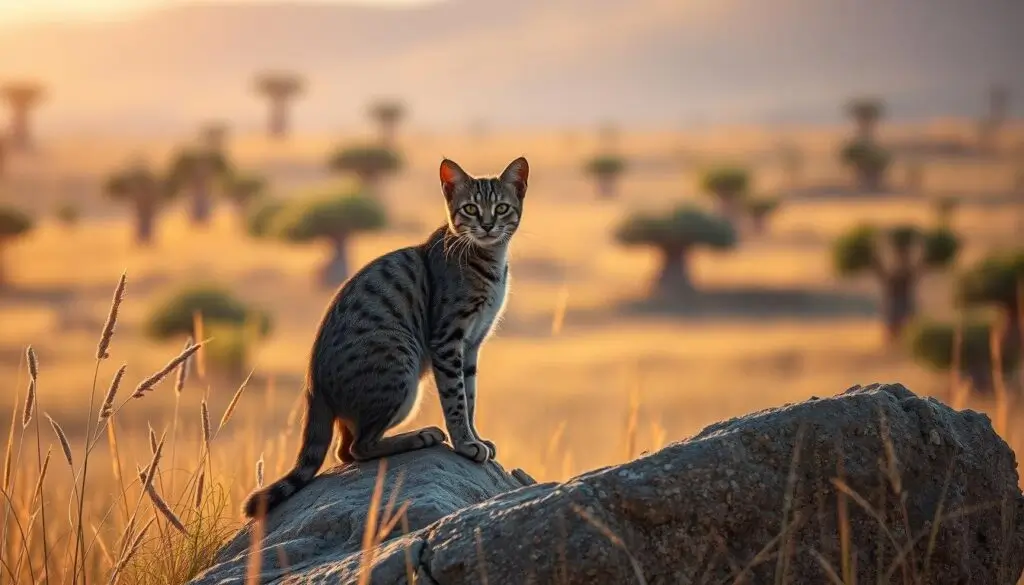Black Footed Cat Lifespan, Size, And Fun Facts You Need To Know
What makes the black footed cat so unique and fascinating? This small wild cat from Africa is one of the smallest cat species. They have a distinct look and interesting habits. Their small size and night-time activities are surprising, yet they thrive in Southern Africa’s savannas and dry grasslands.
Learning about the black footed cat reveals how their lifespan, size, and behavior are linked. Their territory size and hunting success rate show their amazing ability to survive and thrive. This makes them a fascinating subject to study, challenging our views of small wild cats.
Table of Contents
Key Takeaways
- The black footed cat is one of the smallest cat species, with a size comparable to the Rusty-Spotted Cat.
- They have a unique appearance, with black feet and a distinctive coat pattern, characteristic of the african wildcat.
- Black footed cats are nocturnal, with a hunting success rate of about 60%, making them skilled predators among small wild cats.
- They primarily consume small mammals, such as rodents, and play a crucial role in controlling local ecosystems.
- Despite being classified as “Least Concern,” black footed cats face threats from poison and traps set for other wildlife, highlighting the need for conservation efforts to protect these small wild cats.
- They have a relatively long lifespan, with some individuals living up to 15 years in captivity, a notable aspect of the black footed cat’s biology.
- Black footed cats are found in varying densities, with estimates suggesting around 1-4 individuals per square kilometer in suitable habitats, making them an important part of the african wildcat population.
The Black-Footed Cat: An Introduction to Africa’s Smallest Wild Cat
Exploring African wildlife, you’ll find the black-footed cat. It’s a fascinating creature that thrives in Southern Africa’s savannas and grasslands. Its light fur and black or brown spots make it a stealthy hunter, one of the best nocturnal predators around.
This cat’s unique look is just the start of its story. It’s an endangered species facing threats like habitat loss and human encroachment. Yet, it’s a key player in its ecosystem, keeping nature in balance.
Physical Characteristics
The black-footed cat’s size and coat are perfect for its home. Weighing 1.5 to 2.5 kg, it moves easily through dense grass. Its camouflage is unmatched, making it a skilled hunter.
Natural Habitat Range
The black-footed cat lives in southern Africa’s grasslands and savannas. Its ability to survive in these places makes it a resilient nocturnal predator.
Learning about the black-footed cat shows its amazing adaptability and unique traits. Sadly, as an endangered species, its future is uncertain. This highlights the importance of conservation to save this incredible animal.
Understanding the Black-Footed Cat’s Unique Size
The black-footed cat is one of the smallest wild cats in Africa. It’s about the size of a domestic cat. This size helps it survive in dry, open grassy areas of sub-saharan Africa. As you learn about small wild cats, you’ll see how the black-footed cat’s size affects its behavior and survival.
Some key characteristics of the black-footed cat’s size include:
- Weight: approximately 1.6-2.4 kg (3.5-5.3 lbs)
- Length: approximately 36-43 cm (14-17 in)
- Height: approximately 25-30 cm (9.8-11.8 in)
This size lets the black-footed cat move easily in its habitat. It makes it a skilled hunter in sub-saharan Africa.
Remember, the black-footed cat is part of a group of small wild cats in Africa. Its size is just one interesting part of its biology. As you learn more, you’ll discover its behavior, habitat, and how it’s protected.
In sub-saharan Africa, the black-footed cat’s size lets it live alongside other predators and prey. Learning about these relationships helps us understand why we need to protect the black-footed cat and its home.
| Characteristic | Value |
|---|---|
| Weight | 1.6-2.4 kg (3.5-5.3 lbs) |
| Length | 36-43 cm (14-17 in) |
| Height | 25-30 cm (9.8-11.8 in) |
Lifespan and Development Stages
The black-footed cat lives about 10-15 years in the wild. In captivity, they can reach up to 15 years. As an endangered species, it’s vital to protect them and their homes. Knowing how they grow helps in saving them.
Many things affect how black-footed cats grow. These include their living space, food, and health. Conservation efforts to keep their homes safe and reduce conflicts with humans can help them live longer.
Things that can shorten a black-footed cat’s life include:
- Habitat loss and fragmentation
- Human-wildlife conflict
- Disease and parasites
- Prey availability and quality
Supporting conservation efforts and protecting endangered species like the black-footed cat is key. This way, we can help these incredible animals survive for a long time.
| Development Stage | Age | Description |
|---|---|---|
| Kittenhood | 0-6 months | Vulnerable and dependent on mother |
| Juvenile | 6-12 months | Learning to hunt and survive independently |
| Adulthood | 1-10 years | Reproductive and territorial behaviors |
Hunting Abilities and Survival Skills
The black-footed cat is a skilled hunter. It uses its nocturnal habits and agility to catch small prey like rodents and birds. These cats can hunt up to 20 miles in one night, showing their efficiency as nocturnal predators.
They adapt well to different environments and avoid larger predators. This is key for their survival.
The black-footed cat can catch and eat many small prey in one night. This is impressive, especially when compared to larger predators like lions. Lions have a success rate of about 20 to 25%. The black-footed cat’s agility and stealth help them thrive in their habitat, making them a unique and fascinating species.

Some key facts about the black-footed cat’s hunting abilities and survival skills include:
- They are capable of leaping as high as 10 feet into the air to catch birds.
- They have strong jaw muscles, allowing them to crush the bones of their prey
- They are skilled at stalking and ambushing their prey, using their excellent night vision
The black-footed cat’s hunting habits and survival skills show their remarkable adaptability and resourcefulness. As nocturnal predators, they are crucial for their ecosystem’s balance. Their conservation is vital for their environment’s health.
Habitat and Territory Requirements
Exploring small wild cats in sub-saharan Africa, you’ll find the black-footed cat’s habitat is unique. They love savannas and grasslands with lots of plants. This gives them cover for hunting and keeps them safe from predators. Their territory is about 10-20 square kilometers, which is smaller than many other wild cats.
Black-footed cats need dense plants and water nearby. They live in dry places like grassy plains and deserts with scrub. Some have been spotted up to 6,600 ft high, showing they can adapt to various environments. They mark their territory with scent and sounds to talk to other cats and show where they are.
Preferred Environmental Conditions
Black-footed cats prefer dry areas with little vegetation. They thrive in the desert grasslands of Botswana, Namibia, and South Africa. Their ability to survive in these tough places shows their incredible resilience and adaptability.
Territory Size and Marking
A black-footed cat’s territory is about 10-20 square kilometers. They use scent and sounds to mark their territory. This is important for showing who’s in charge and to find a mate. Learning about their habitat and territory will help you appreciate these amazing small wild cats in sub-saharan Africa.
Diet and Hunting Patterns
The black-footed cat is a skilled hunter. It mainly eats small mammals, birds, and reptiles. It can catch prey up to three times its own weight, showing its agility and strength.
Its diet includes small mammals, birds, reptiles, and insects. Birds make up 25% of its diet. The rest is small mammals and other prey. As nocturnal predators, they hunt a lot. They can silently kill 10-14 small animals in one night.
Some key facts about the black-footed cat’s hunting habits include:
- Average weight range of 2.2-5.5 lbs, allowing them to catch prey of varying sizes
- Predation success rate of approximately 60%
- Estimated time spent hunting is as much as 70%

Understanding the black-footed cat’s diet and hunting patterns is key. Their hunting habits are vital for survival. It’s important to protect their habitat and prey populations.
Reproduction and Breeding Habits
The black-footed cat breeds all year round. They have a gestation period of about 60-70 days. A litter usually has 1-4 kittens. As an endangered species
Conservation efforts are key to save the black-footed cat’s home. Here are some important facts about their breeding:
- A female usually has two kittens in the Southern Hemisphere summer.
- Kittens stop nursing at about two months and become independent at four months.
- Their breeding is suited to their solitary and night-loving lifestyle.
Supporting conservation efforts is crucial. It helps protect the black-footed cat and its home. This ensures the survival of this unique and interesting species.
| Category | Description |
|---|---|
| Gestation Period | 60-70 days |
| Litter Size | 1-4 kittens |
| Breeding Season | Throughout the year |
Conservation Status and Threats
The black-footed cat is listed as vulnerable on the IUCN Red List. Its population is declining due to habitat loss, human-wildlife conflict, and disease. To protect this endangered species, we need conservation efforts. Supporting organizations that protect its habitat and reduce conflict is key.
Major threats to the black-footed cat include:
- Habitat loss and fragmentation
- Human-wildlife conflict
- Disease
Efforts are being made to save the black-footed cat and its home. These include:
- Habitat preservation and restoration
- Research to understand the cat’s behavior and population
- Community education to lessen human-wildlife conflict
Supporting these efforts can help protect the black-footed cat and other endangered species. Every action counts, and together, we can make a big difference.
| Species | Conservation Status | Threats |
|---|---|---|
| Black-footed Cat | Vulnerable | Habitat loss, human-wildlife conflict, disease |
| Black-footed Ferret | Endangered | Habitat loss, disease, lack of genetic variation |
Behavioral Characteristics and Social Structure
Exploring small wild cats in sub-saharan africa, you find the black-footed cat is alone. It has a big home range and hunts at night. This makes it different from other cats. It uses scent and sounds to talk to other cats.
The black-footed cat likes to be alone. Occasional interactions with others happen, like when they mate or fight over territory. These cats have learned to live well in sub-saharan africa, using special skills.
Some key traits of the black-footed cat are:
- Nocturnal hunting habits, allowing it to conserve energy and avoid predators
- Use of scent markings to define its territory and communicate with other cats
- Vocalizations, such as meows and purrs, to convey emotions and intentions
In sub-saharan africa, the black-footed cat’s way of living is shaped by being alone and having a big area. Learning more about these cats, you’ll see how amazing they are and how they fit into their world.
Relationship with Other African Wild Cats
The black-footed cat lives alongside other wild cats in Africa, like leopards and cheetahs. Its small size and night-time habits help it avoid competition. It uses its sharp hearing and hunting skills to find food accurately, similar to the African wildcat.
Its territorial behavior also plays a role in its interactions with other cats. It uses scents and sounds to talk to other cats. This helps it stay away from bigger predators, just like the African wildcat does.
The black-footed cat is one of the smallest wild cats in Africa, weighing 1 to 2.45 kg. The African wildcat is a bit larger but still small. Here’s a comparison of their physical traits:
| Species | Weight (kg) | Length (cm) |
|---|---|---|
| Black-footed cat | 1-2.45 | 36-43 |
| African wildcat | 3-6 | 50-60 |
The black-footed cat’s relationship with other wild cats is complex. Its unique adaptations and territorial behavior are key. Understanding these relationships helps us see why we need to protect these small wild cats.
Conclusion: Protecting the Future of the Black-Footed Cat
The black-footed cat’s future is uncertain. Its population is falling, and threats to its survival are ongoing. It’s listed as “Vulnerable” on the IUCN Red List. This small wild cat needs urgent conservation to keep it alive.
Despite its 60% hunting success rate, there are only about 10,000 black-footed cats left. This is a big worry.
Zoos like the Smithsonian National Zoo and the Philadelphia Zoo are working hard. They breed and release black-footed cats into the wild. These efforts, along with saving habitats and engaging with communities, are key to protecting this endangered species.
By supporting these conservation efforts, you can help save the black-footed cat. Your help is crucial for its survival for many years to come.
They can leap up to 10 feet in the air to catch birds
